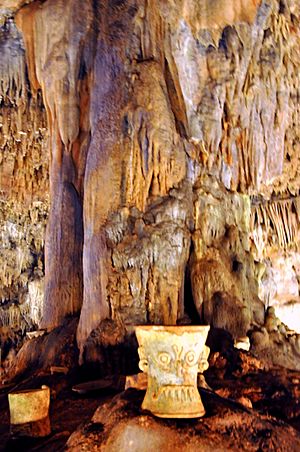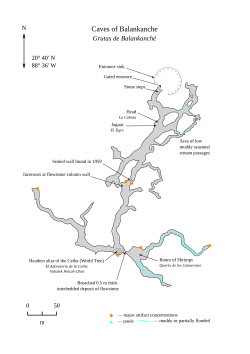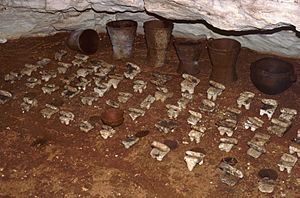Balankanche facts for kids
Balankanche is an ancient Maya cave site in Mexico. It is very close to the famous Maya city of Chichen Itza in Yucatán. For over 2,000 years, this cave has been a sacred place. People performed rituals there to honor the Maya rain god, Chaac. Later, they also honored Tlaloc, the rain god of the Toltec people.
Many explorers and scholars have studied Balankanche. Edward Herbert Thompson and Alfred Tozzer visited in 1905. Since 1932, Mexican and US experts have explored the cave. They found small buildings and platforms near the entrance. Inside, they discovered stairs, walls, and altars. They also found many ritual items. These included ceramic pots (especially censers for burning incense) and small stone tools. Today, Balankanche is open for visitors to explore.
Contents
What is Balankanche?
Balankanche means "Throne of the Sacred Jaguar" in the Maya language. It is a large cave system. This cave was a very important religious site for the ancient Maya people. They believed it was a special place where they could connect with their gods.
Why was the cave important?
The Maya people depended on rain for their crops, especially corn. They believed that rain gods lived in caves. So, Balankanche became a key spot for rain rituals. People would go deep into the cave to ask the gods for rain.
Who were the rain gods?
The main rain god for the Maya was Chaac. He was often shown with a long nose and sometimes holding an axe. The Toltec people, who also lived in Mexico, had their own rain god named Tlaloc. Tlaloc had large, goggle-like eyes and fangs. Both gods were honored at Balankanche.
Exploring the Cave
The Balankanche cave system is quite large. It has many passages and chambers. Explorers have found signs of human activity deep inside. This shows that people went far into the cave for their ceremonies.
What did explorers find?
When scholars explored the cave, they found many artifacts. These were items left behind by the ancient Maya. They included:
- Ceramic pots: Many of these were censers, used for burning incense during rituals.
- Small stone tools: These tiny tools were likely used for processing corn or other ritual purposes.
- Altars: These were special platforms where offerings were placed.
- Walls and stairs: Some parts of the cave were modified by the Maya.
The "World Tree" Chamber
One of the most famous parts of the cave is the "World Tree" chamber. In this chamber, a large stalactite and stalagmite formation looks like a tree. The Maya believed this represented the "World Tree." This tree connected the sky, the earth, and the underworld. It was a very sacred symbol for them.
History of Discovery
Balankanche has been known for a long time. Local Maya people always knew about its importance. However, it was first explored by Western scholars in the early 20th century.
Early Explorers
Edward Herbert Thompson was an American archaeologist. He visited Balankanche in 1905 with Alfred Tozzer. They were among the first to document the cave's archaeological importance.
Later Studies
More detailed studies began in 1932. Since then, many Mexican and American researchers have worked at the site. Their work has helped us understand the rituals and beliefs of the ancient Maya. They have also helped preserve the cave.
Visiting Balankanche Today
Today, Balankanche is a protected archaeological site. It is open to the public. Visitors can take guided tours into the cave. This allows them to see the amazing rock formations and learn about the ancient Maya rituals. It's a unique way to step back in time and experience a sacred place.
See also
 In Spanish: Balankanché para niños
In Spanish: Balankanché para niños




